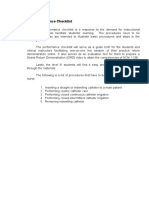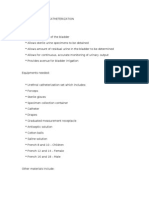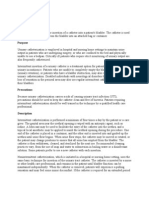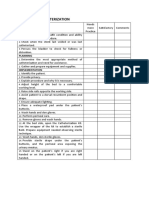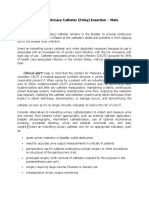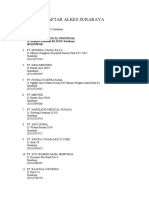Urology
Urology
Uploaded by
Drmirfat AlkashifCopyright:
Available Formats
Urology
Urology
Uploaded by
Drmirfat AlkashifCopyright
Available Formats
Share this document
Did you find this document useful?
Is this content inappropriate?
Copyright:
Available Formats
Urology
Urology
Uploaded by
Drmirfat AlkashifCopyright:
Available Formats
Urinary catheterization
Definition: the insertion of a hollow, flexible tube through the urethra into the urinary bladder, it is
commonly made of rubber or plastic with different sizes.
Purpose: to drain the bladder urine due to an obstruction or incontinence.
Indications:
• Surgical patients.
• Patients undergoing urological surgery.
• Urinary retention.
• Urinary incontinence.
Types of lower urinary tract catheters:
1. One way catheter
2. Two way catheter (double lumen)
3. Three way catheter (triple lumen)
Preparation:
• Check prescriber’s order to ensure that the procedure specifies a straight or indwelling catheter.
• Determine if the patient is unconscious, hard of hearing, blind, or if there are any restrictive
devices attached, such as restraints, traction, or casts.
• Note on lab form if patient is having a menstrual period if specimen is obtained for diagnostic
study.
• Because the urethra is close to the anus in female patients, thorough and careful cleaning of the
perineum is very important before catheter insertion to reduce the incidence of infection.
Equipment needed:
1. Sterile Foley catheterization/ straight catheterization tray:
2. Sterile gloves.
3. Drape.
4. Lubricant.
5. Antiseptic cleaning wipes.
6. Cotton balls and pickup forceps.
7. Prefilled syringe of sterile water.
8. Catheter of correct size.
9. Tape.
10. Specimen container (optional).
11. Light.
Urology procedures / Dr. Sahar Ali Page 1
12. Bath blanket.
13. Disposable glove, basin of warm water, soap, towel, and disposable wash cloth.
Assessment:
• Level of awareness.
• Mobility and physical limitation.
• Patient's age and gender.
• If patient has distended bladder.
Implementation:
1. Introduce self and verify the patient's identity using agency protocol.
2. Explain to the patient what you are going to do, why it is necessary, and how he or she can
participate.
Rationale: Promote patients' cooperation.
3. Place the patient in the appropriate position and drape all areas except the perineum.
(Dorsal recumbent position with knees flexed, feet about 2 feet apart, and hips slightly externally
rotated).
Rationale: Allow relaxation of muscles and easy access to urinary meatus.
4. Drape patient with bath blanket, covering upper body and shaping over both knees and legs,
leaving genital area exposed.
Rationale: Prepare patient for procedure and provides for privacy.
Dorsal recumbent position
5. Place waterproof absorbent pad under patient's buttocks.
Rationale: Protects bed linens.
6. Arrange supplies and equipment on bedside table. Provide a good light.
Rationale: Easy access prevents possible contamination.
7. Don clean gloves and wash perineal area with mild soap and warm water with disposable wash
cloth.
Rationale: Decreases microorganisms at the site.
8. Remove disposable gloves and place in proper receptacle.
Urology procedures / Dr. Sahar Ali Page 2
Rationale: Reduces the spread of microorganisms.
9. Facing patient, stand on right side of bed if right handed, on left side if left-handed.
Rationale: Successful catheter insertion requires nurse to assume comfortable position with all
equipment close by.
10. Open packaging using sterile technique. Don sterile gloves.
Rationale: Allows nurse to handle sterile supplies without contamination.
11. If indwelling catheter is used, test balloon by injecting normal saline or sterile water into
balloon lumen until balloon is inflated; then aspirate saline or sterile water.
Rationale: Assesses integrity of balloon. If balloon fails to inflate, another sterile catheter is
necessary.
12. Add antiseptic to cotton balls; open lubricant container. Lubricate catheter about (3.5 to 5 cm).
Rationale: Maintains principles of surgical asepsis and organizes work area. Lubricating
catheter reduces the chance of friction causing trauma to the delicate mucous membranes of the
urethra.
13. Wrap edges of sterile drape around gloved hands and request patient to raise hips; then slide
drape under patient's buttocks.
Rationale: Protects hands from contamination while placing towel under edge of patient's
buttocks.
14. Cleanse perineal area using forceps to hold cotton balls soaked in antiseptic solution.
Rationale: Cleansing reduces number of microorganisms at urethral meatus.
a. Spread labia minora with thumb and index finger of non-dominant hand to expose meatus;
continue to hold throughout insertion of catheter.
b. With other hand, use forceps to hold cotton balls soaked in antiseptic solution.
c. Cleanse area from clitoris toward anus, using a different sterile cotton ball each time first to the
right of the meatus, then to the left of the meatus, then down the center over meatus.
Full separation of labia
15. Pick up catheter with free sterile gloved hand near the tip; lubricate the catheter; hold remaining
part of catheter coiled in hands; place distal end in basin.
Rationale: Placing distal end of catheter in basin allows for urine collection. Coiling catheter in
hand and holding near the tip allows easier manipulation during insertion.
Urology procedures / Dr. Sahar Ali Page 3
16. Insert catheter gently, about 5 to 10 cm.
17. If, when inserting an indwelling catheter, urine flow is established, insert catheter 3.5 cm
farther.
18. Inflate balloon with 10 mL sterile water, watching patient's face for grimacing (a sign that
balloon is inflating in urethra); if this occurs, deflate balloon and reposition catheter as above.
19. Gently pull back on catheter until resistance is felt as balloon rests at orifice of urethra.
Inflate balloon with 10 mL sterile water
20. Collect urine specimen, if needed, by placing open lumen end of catheter into specimen
container.
Rationale: Allows for sterile specimen to be obtained for culture and sensitivity.
21. For an indwelling catheter:
a. Attach end of catheter to collecting tube of drainage system, holding drainage bag below
bladder level.
b. Attach collection bag to side of bed.
c. Secure catheter to patient.
Rationale: Minimizes tension and trauma to urethral opening.
22. Tape catheter to inner thigh
23. Dry perineal area.
24. Label urine specimen with patient's name, date, physician's name. And transport to laboratory.
25. Assess flow of urine and drainage tubing setup.
26. Documentation:
a. Type and size of catheter.
b.Amount of solution to inflate balloon.
c. Characteristics of urine.
d.Amount of urine.
e. Reason for catheterization.
f. Specimen collected.
Urology procedures / Dr. Sahar Ali Page 4
27. Report any unusual findings immediately:
No urine output.
Bladder discomfort despite catheter patency.
Leakage of urine from catheter.
Inability to insert catheter.
Nurse must assess; discomfort could indicate infection, leakage around catheter could indicate
improper catheter placement or inflation of balloon.
Urology procedures / Dr. Sahar Ali Page 5
Catheter care
Definition: Perineal care practices for patients with indwelling catheters to reduce the chance of
developing a urinary tract infection.
Purpose: to decrease the chance of acquiring urinary tract infection.
Preparation:
• Determine patient’s ability to understand and cooperate in the procedure.
• Assess for signs and symptoms of urinary infection.
• Determine an appropriate time for catheter care.
Special Considerations:
• Catheter care is most beneficial if performed after defecation if patient is incontinent.
• Note if patient is having menstrual period or vaginal discharge and, because the urethra is close
to the anus, thorough and careful cleaning of the perineum is very important.
Equipment needed:
1. Sterile package.
2. Disposable gloves.
3. Bed protector.
4. Bath blanket.
5. Basin of warm water and mild soap.
6. Towel and disposable washcloth.
7. Sterile swabs (to apply ointment).
8. Small plastic bag for trash.
Assessment:
• How long catheter has been in place.
• For any discharge around urethral meatus.
• For complaints of pain.
• Patient's temperature; Assess temperature every 4 hours for 24 hours if odor or exudate is
present.
• Patient's intake; Maintain adequate fluid intake.
Urology procedures / Dr. Sahar Ali Page 6
Implementation:
1. Position patient (dorsal recumbent position in bed).
2. Place waterproof disposable pad under patient's buttocks and to the side from which catheter
care given.
3. Drape patient with bath blanket, exposing only perineal area.
Rationale: Maintain privacy.
4. Open separate sterile packages observing sterile technique.
5. Don clean gloves.
Rationale: Prevents accidental contamination if supplies are close by.
6. Arrange refuse bag (small plastic bag).
7. Cleans the perineal area with mild soap and warm water and pat dry.
Female: Gently retract labia away from urinary meatus and hold in position.
8. Release labia of female patient.
9. Observe meatus, catheter, and surrounding tissue to determine presence or absence of
inflammation, edema, malodorous exudates, color of tissue, and burning sensation.
10. Dispose of equipment and linen, remove gloves and dispose of in proper receptacle.
11. Wash hands.
Rationale: Reduces spread of microorganisms.
12. Re-tape catheter to thigh.
Rationale: Prevents trauma and pain from tension and pulling.
13. Assess flow of urine through tubing.
14. Empty drainage bag at least every 8 hours or as necessary to prevent backup of urine into the
tubing (and up into the bladder).
15. Documentation:
a. Time.
b.Procedure.
c. Assessment of urinary meatus.
d.Character of urine.
e. Patient response.
16. Report any unusual findings immediately, may require further therapy.
Urology procedures / Dr. Sahar Ali Page 7
Catheter removal
Purpose: to decrease the chance of developing urinary tract infection.
Preparation: Provide privacy.
Equipment needed:
1. Disposable gloves.
2. 10-mL syringe without a needle.
3. Water proof pad.
4. Small plastic bag for trash.
Assessment:
• Note length of time catheter has been in place. The longer the catheter has been in place, the
greater the risk for decreased bladder muscle tone and inflammation of the urethra.
• Assess the patient's knowledge of what to expect, many patients anticipate discomfort or fear of
ability to void successfully after removal of the catheter.
Implementation:
1. Insert hub of syringe into inflation valve (balloon port) aspirate until tubing collapses.
Rationale: Indicates that entire contents of balloon have been removed.
2. Remove catheter steadily and smoothly.
3. If any resistance is noted, repeat step 1 to remove remaining water.
Rationale: Prevents trauma to the urethra.
4. Wrap catheter in waterproof pad. Unhook collection bag and drainage tubing from the bed.
Rationale: Prevents any leakage from the catheter onto the patient, nurse, or bed linens.
5. Measure urine, and empty drainage bag.
6. Record output.
7. Cleans the perineum with soap and water, and dry area thoroughly.
Rationale: Promotes comfort and a feeling of cleanliness.
8. Explain to patient:
a. It is important to have a fluid intake of 1.5 to 2 L/day unless contraindicated.
b. Explain that many patients experience mild burning or discomfort with first voiding which
soon subsides.
c. Inform the patient to report any signs of urinary tract infection. (Urgency, burning,
frequency, excreting small amount and pain/discomfort, which are most likely to develop in
2 to 3 days.)
Urology procedures / Dr. Sahar Ali Page 8
9. Documentation and report:
a. Time catheter was removed.
b. Teaching related to increasing fluid intake and signs and symptoms of urinary tract infection.
c. Time, amount, and characteristics of first voiding.
d. Complete intake and output record.
Urology procedures / Dr. Sahar Ali Page 9
You might also like
- Acute Coronary Syndrome NCP 02Document6 pagesAcute Coronary Syndrome NCP 02AgronaSlaughterNo ratings yet
- Urinary CatheterDocument13 pagesUrinary CatheterjeorjNo ratings yet
- Indwelling Urinary Catheterization 1Document5 pagesIndwelling Urinary Catheterization 1Mercy Anne EcatNo ratings yet
- Access To Special Care Dentistry, Part 5. Safety: A. Dougall and J. FiskeDocument14 pagesAccess To Special Care Dentistry, Part 5. Safety: A. Dougall and J. FiskeMostafa FayadNo ratings yet
- DIALOGUEDocument6 pagesDIALOGUEAlexis Angel DiMaria Muñoz QNo ratings yet
- 6 Urinary EliminationDocument5 pages6 Urinary EliminationkhautedameNo ratings yet
- Indwelling Urinary CatheterizationDocument5 pagesIndwelling Urinary CatheterizationNiña Jean Tormis Aldaba100% (1)
- CatheterizationDocument23 pagesCatheterizationyuuki konnoNo ratings yet
- Female Urinary Cathterization PDFDocument8 pagesFemale Urinary Cathterization PDFmeseretNo ratings yet
- CatheterizationDocument3 pagesCatheterizationBarangay RizalNo ratings yet
- CatheterizationDocument43 pagesCatheterizationJen Tirapan100% (2)
- Fundam Nursing Skill Lab ManualDocument97 pagesFundam Nursing Skill Lab ManualBirhanu AyenewNo ratings yet
- CatheterizationDocument46 pagesCatheterizationJam Maj67% (6)
- Female CatheterizationDocument5 pagesFemale Catheterization4xf9szs4rxNo ratings yet
- Assemble EquipmentDocument2 pagesAssemble EquipmentMc Joewell HudencialNo ratings yet
- Bedpans and UrinalsDocument4 pagesBedpans and UrinalsCham De Leon50% (4)
- Indwelling Urinary CatheterizationDocument8 pagesIndwelling Urinary CatheterizationNiña Jean Tormis AldabaNo ratings yet
- NCM - CatheterizationDocument3 pagesNCM - CatheterizationYanna Habib-MangotaraNo ratings yet
- Urinary EliminationDocument9 pagesUrinary EliminationTuTitNo ratings yet
- Insertion of TubesDocument29 pagesInsertion of Tubesqopcyrus10No ratings yet
- Providing Catheter CareDocument2 pagesProviding Catheter CareMarcia Almeida100% (1)
- Urinary CatheterizationDocument35 pagesUrinary CatheterizationrnrmmanphdNo ratings yet
- CATHETERIZATIONDocument13 pagesCATHETERIZATIONSarah Uy Caronan100% (1)
- 2022 PR Catheterization Copy 3Document3 pages2022 PR Catheterization Copy 3Aj Vhert RojoNo ratings yet
- Unit - 6Document50 pagesUnit - 6nagesageshu6No ratings yet
- NCM 109 SKILLS LAB DAY 5.3 Catheterization22Document33 pagesNCM 109 SKILLS LAB DAY 5.3 Catheterization22Joseph DusichNo ratings yet
- Performing Urinary CatheterizationDocument46 pagesPerforming Urinary CatheterizationAbelNo ratings yet
- Catheterization DemoDocument48 pagesCatheterization Demojonna casumpangNo ratings yet
- Check List of Urinary Catheterization For EMT LevelDocument12 pagesCheck List of Urinary Catheterization For EMT LevelFikir Ligisinaw AyalkimNo ratings yet
- Urinary CatheterizationDocument37 pagesUrinary CatheterizationCharles100% (2)
- Intake and Output (I and O) Monitoring Brief DescriptionDocument4 pagesIntake and Output (I and O) Monitoring Brief DescriptionJan Crizza Dale R. FrancoNo ratings yet
- Male Female Catheterization Rle 30Document95 pagesMale Female Catheterization Rle 30HoneylouAzOpondaNo ratings yet
- Urinary-Catherterization ChecklistDocument9 pagesUrinary-Catherterization ChecklistRaynelah NonanNo ratings yet
- Catheter Checklist-Dr HayatDocument3 pagesCatheter Checklist-Dr HayatMohamed OmarNo ratings yet
- CATHETERIZATIONDocument5 pagesCATHETERIZATIONMonica JubaneNo ratings yet
- Jayita's Topic Catheter Care NewDocument7 pagesJayita's Topic Catheter Care NewJayita Gayen Dutta100% (1)
- Urinary CatheterizattionDocument85 pagesUrinary Catheterizattionbajaoc100% (6)
- Sri Venkateswara Institute of Medical Sciences College of Nursing Tirupati, Andhra PradeshDocument13 pagesSri Venkateswara Institute of Medical Sciences College of Nursing Tirupati, Andhra Pradeshomkaram venkateswarluNo ratings yet
- An Assi Gnment On Cat Het Eri Zat I OnDocument17 pagesAn Assi Gnment On Cat Het Eri Zat I OnGyanbhushan BhartiNo ratings yet
- Return Demo Skills StepsDocument9 pagesReturn Demo Skills StepsJeannie RobisNo ratings yet
- Inserting An Indwelling CatheterDocument4 pagesInserting An Indwelling CatheterMarcia AlmeidaNo ratings yet
- Revised NCM 109 Rle Procedure CatheterizationDocument16 pagesRevised NCM 109 Rle Procedure CatheterizationFRANCES EMMA NIERE GUMAHADNo ratings yet
- Urinary Catheterization Nursing ProcedureDocument6 pagesUrinary Catheterization Nursing ProcedureDencel BarramedaNo ratings yet
- Urinary CatheterizationDocument23 pagesUrinary CatheterizationJudith PamellaNo ratings yet
- NGT Ifc EtDocument2 pagesNGT Ifc EtYves RamosNo ratings yet
- The Performance Checklist: Lesson 7Document17 pagesThe Performance Checklist: Lesson 7Mae JavierNo ratings yet
- Male CatheterizationDocument30 pagesMale CatheterizationJoeurielle CarteraNo ratings yet
- CatheterizationDocument7 pagesCatheterizationMomee BarmanNo ratings yet
- Catheterization & CystoclysisDocument6 pagesCatheterization & Cystoclysisclariceportin12No ratings yet
- Urinary Catheterization FemaleDocument13 pagesUrinary Catheterization Femaleroger100% (1)
- Urinary Catheterization: AssessmentDocument2 pagesUrinary Catheterization: AssessmentJozamae NocedoNo ratings yet
- Urinarycatheterization 091016170505 Phpapp01Document24 pagesUrinarycatheterization 091016170505 Phpapp01Surya TejaNo ratings yet
- Skills Laboratory NCM 103: Prof. Michael H. EsmillaDocument30 pagesSkills Laboratory NCM 103: Prof. Michael H. EsmillaHannah Leigh CastilloNo ratings yet
- Week 7 FC Insertion and RemovalDocument28 pagesWeek 7 FC Insertion and RemovalLeslie Jane RoxasNo ratings yet
- Urinary Elimination and CatheterizationDocument41 pagesUrinary Elimination and CatheterizationMaria Margarita100% (1)
- Indwelling Urinary Catheter - MaleDocument9 pagesIndwelling Urinary Catheter - MaleVinz Khyl G. CastillonNo ratings yet
- CatheterizationDocument31 pagesCatheterizationThe GreatNo ratings yet
- Urinary Interventions: By: Nursing Skills Laboratory GroupDocument57 pagesUrinary Interventions: By: Nursing Skills Laboratory GroupMelinda Cariño BallonNo ratings yet
- Removal of CatheterDocument2 pagesRemoval of CatheterMargaret ArellanoNo ratings yet
- SURG Demonstration ChecklistDocument5 pagesSURG Demonstration ChecklistMian SimporiosNo ratings yet
- نوره مهدىDocument11 pagesنوره مهدىDrmirfat AlkashifNo ratings yet
- Nwafoh FinalDocument86 pagesNwafoh FinalDrmirfat AlkashifNo ratings yet
- Effect of Evidence-Based Practice Program on Internship Students' Performance at the Maternity Nursing DepartmentsDocument21 pagesEffect of Evidence-Based Practice Program on Internship Students' Performance at the Maternity Nursing DepartmentsDrmirfat AlkashifNo ratings yet
- Design For ResearchDocument54 pagesDesign For ResearchDrmirfat AlkashifNo ratings yet
- Lesson (13) Collection of SpecimensDocument10 pagesLesson (13) Collection of SpecimensDrmirfat AlkashifNo ratings yet
- Lesson (12) Stoma CareDocument5 pagesLesson (12) Stoma CareDrmirfat AlkashifNo ratings yet
- Final Sheet POD (NRSG-3302)Document8 pagesFinal Sheet POD (NRSG-3302)Drmirfat AlkashifNo ratings yet
- Kylie Armstrong ThesisDocument369 pagesKylie Armstrong ThesisDrmirfat AlkashifNo ratings yet
- Lesson (6) Assessment of Gestational AgeDocument26 pagesLesson (6) Assessment of Gestational AgeDrmirfat AlkashifNo ratings yet
- A Randomised, Double-Blind, Placebo-Controlled Study: Acupressure Treatment of Morning Sickness in PregnancyDocument5 pagesA Randomised, Double-Blind, Placebo-Controlled Study: Acupressure Treatment of Morning Sickness in PregnancyDrmirfat AlkashifNo ratings yet
- Blood SampleDocument12 pagesBlood SampleDrmirfat AlkashifNo ratings yet
- The Use of Fresh Ginger Herbs As A Home Remedy To Relieve Primary DysmenorrheaDocument10 pagesThe Use of Fresh Ginger Herbs As A Home Remedy To Relieve Primary DysmenorrheaDrmirfat AlkashifNo ratings yet
- Thesis 2Document94 pagesThesis 2Drmirfat AlkashifNo ratings yet
- 766Document106 pages766Drmirfat AlkashifNo ratings yet
- Cover PageDocument7 pagesCover PageDrmirfat AlkashifNo ratings yet
- 3.6.2020 Final Final Manual - Logbook For Students For Adult 2Document34 pages3.6.2020 Final Final Manual - Logbook For Students For Adult 2Drmirfat AlkashifNo ratings yet
- Evidence Based PracticeDocument26 pagesEvidence Based PracticeDrmirfat AlkashifNo ratings yet
- Skin Sutures and StaplesDocument4 pagesSkin Sutures and StaplesDrmirfat AlkashifNo ratings yet
- Clinical Handout - NGT Feeding .Document2 pagesClinical Handout - NGT Feeding .Drmirfat AlkashifNo ratings yet
- TractionDocument24 pagesTractionDrmirfat AlkashifNo ratings yet
- Blood TransfusionDocument28 pagesBlood TransfusionDrmirfat AlkashifNo ratings yet
- Course Spec NRSG 352 Sec Sem1441Document10 pagesCourse Spec NRSG 352 Sec Sem1441Drmirfat AlkashifNo ratings yet
- Nasogastric TubeDocument9 pagesNasogastric TubeDrmirfat AlkashifNo ratings yet
- "COVID Is Fake Sick Actually Have Influenza A or B", by Dr. Derek KnaussDocument2 pages"COVID Is Fake Sick Actually Have Influenza A or B", by Dr. Derek KnaussSANDRA BAGGNo ratings yet
- Who's Meant To Be Teaching Us - Wakley Prize Essay, Dec 2011, LancetDocument2 pagesWho's Meant To Be Teaching Us - Wakley Prize Essay, Dec 2011, LancetIrina CristescuNo ratings yet
- Pre-Operative Conference: Sarah Manaloto MDDocument39 pagesPre-Operative Conference: Sarah Manaloto MDSarah ManalotoNo ratings yet
- FULL-TEXT - NCLEX-RN Practice Quiz Test Bank 1 - NurseslabsDocument82 pagesFULL-TEXT - NCLEX-RN Practice Quiz Test Bank 1 - NurseslabsRonaldo Matos PerezNo ratings yet
- Dr. G. M. Taori: Curriculum VitaeDocument12 pagesDr. G. M. Taori: Curriculum Vitaesrajan sahuNo ratings yet
- Daftar Alkes Surabaya: 2. Pt. B-Braun Medical Indonesia Jl. Manyar Kertoadi B1 H/331 Surabaya (031) 5938248Document4 pagesDaftar Alkes Surabaya: 2. Pt. B-Braun Medical Indonesia Jl. Manyar Kertoadi B1 H/331 Surabaya (031) 5938248chan27100% (1)
- Neonatal Acute Kidney InjuryDocument58 pagesNeonatal Acute Kidney InjuryRadhika BatraNo ratings yet
- RRS at RRLDocument19 pagesRRS at RRLNicole MangosanNo ratings yet
- Vet Obst Lecture 10 Cesarean in Domestic Farm and Pet AnimalsDocument41 pagesVet Obst Lecture 10 Cesarean in Domestic Farm and Pet Animalsgnpobs100% (1)
- Vincent 2009Document6 pagesVincent 2009Guillermo Obando LaraNo ratings yet
- Download ebooks file Primary Care Mental Health 1st Edition Linda Gask all chaptersDocument60 pagesDownload ebooks file Primary Care Mental Health 1st Edition Linda Gask all chaptersabelnolwenty100% (7)
- Reducing Waste in ICUDocument10 pagesReducing Waste in ICUzorbini69No ratings yet
- 2018 Assessment Tool BSFDocument24 pages2018 Assessment Tool BSFRugay LaboratoryNo ratings yet
- Finals OSCE Checklist OriginalDocument15 pagesFinals OSCE Checklist OriginalKavit KNo ratings yet
- Cardiorenal Syndrome - Cardiologist vs. Nephrologist - ACVIM 2014 - VINDocument5 pagesCardiorenal Syndrome - Cardiologist vs. Nephrologist - ACVIM 2014 - VINTactvisNo ratings yet
- Gi ProformaDocument6 pagesGi ProformaPraveen RavishankaranNo ratings yet
- LP + Askep CKD ON HDDocument51 pagesLP + Askep CKD ON HDArista BaruNo ratings yet
- Measuring Basic Observations Vital Signs OSCE GuideDocument9 pagesMeasuring Basic Observations Vital Signs OSCE GuidedrpeterimojeNo ratings yet
- AnnexE List of Medical Case Rates For Primary Care Facilities-Infirmaries DispensariesDocument14 pagesAnnexE List of Medical Case Rates For Primary Care Facilities-Infirmaries DispensariesrhenzelamparoNo ratings yet
- The Positive Impact of Dental Care Coordination Across An Interdisciplinary Population Spectrum in A Large Urban Health Center SetDocument10 pagesThe Positive Impact of Dental Care Coordination Across An Interdisciplinary Population Spectrum in A Large Urban Health Center SetScivision PublishersNo ratings yet
- SelList R1Document35 pagesSelList R1Abhishek GuptaNo ratings yet
- Drug Study On Emergency DrugsDocument16 pagesDrug Study On Emergency DrugsJosepNo ratings yet
- Reactive Disorders of The SkinDocument46 pagesReactive Disorders of The SkinhaniNo ratings yet
- Asuhan Kebidanan Komprehensif Pada Ny I Umur 35 TaDocument6 pagesAsuhan Kebidanan Komprehensif Pada Ny I Umur 35 TaWienta dsNo ratings yet
- What Is Gastroesophogeal Reflux DiseaseDocument14 pagesWhat Is Gastroesophogeal Reflux DiseaseAhmed SadNo ratings yet
- Invoice 2001381Document1 pageInvoice 2001381ersalonga8No ratings yet
- The Safe Use of Difficult and Dangerous Acupuncture PointsDocument5 pagesThe Safe Use of Difficult and Dangerous Acupuncture PointsChandra MosesNo ratings yet













































